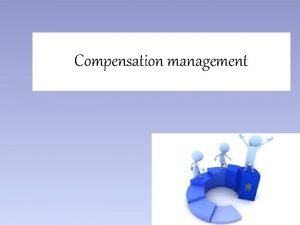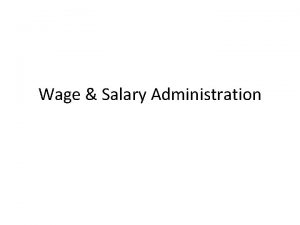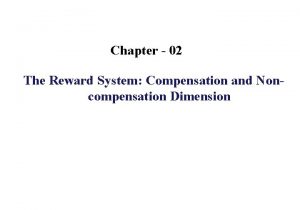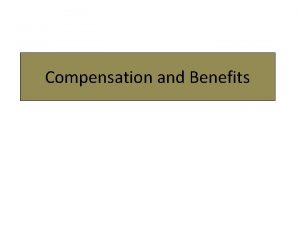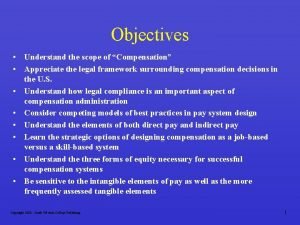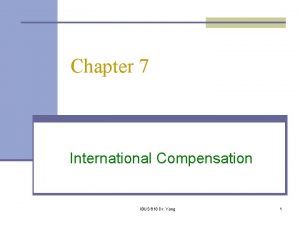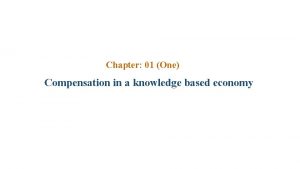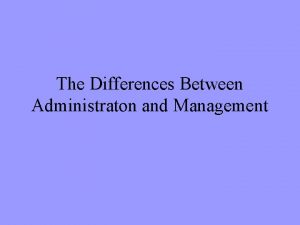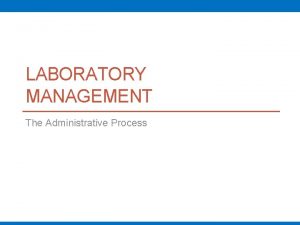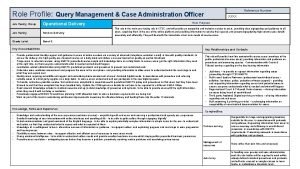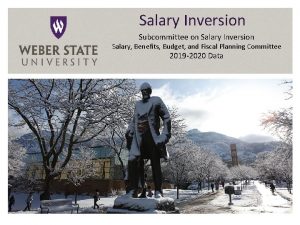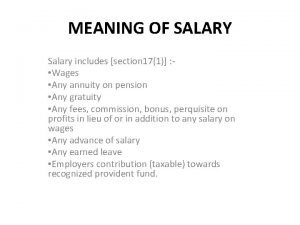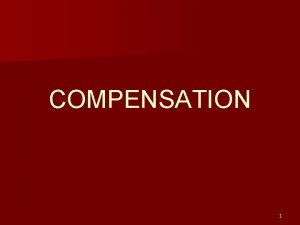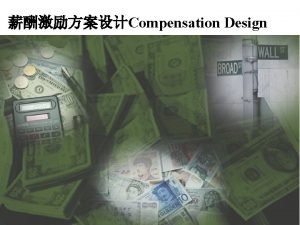Compensation management MEANING Wage and salary administration refers




















- Slides: 20

Compensation management

MEANING • Wage and salary administration refers to the establishment and implementation of sound policies and practices of employee compensation. Thus, it is: • administration of employee compensation. • systematic approach to provide monetary value to employees. • establishment and maintenance of equitable as well as costeffective wage structure.

DEFINITIONS “Wage and salary administration denotes the process of managing a company’s compensation programme. ” - S. P. Robbins “ Wage and salary administration is essentially the application of a systematic approach to the problem of ensuring that employees are paid in a logical and fair manner. " - Bewath & Reins

Definitions COMPENSATION: Compensation may be defined by as money received in performance of work plus many kinds of services and benefits that organisation s provide to their employees. Compensation may be classified into (a) Base or primary compensation and (ii) Supplementary compensation. Primary compensation refers to basic pay in the form of wages and salaries. It is a fixed and non-incentive payment on the basis of time expended on the job. Supplementary compensation consists of incentive and variable payments, based on either individual output or output of the group as a whole. WAGE: Wage is a general term referring to direct monetary compensation. It is also used specifically to refer to payments to service workers on the basis of hourly rated production.

Definitions (contd. ) SALARY: Salary refers to weekly or monthly rates paid to clerical, administrative and professional employees. WAGE LEVELS: The wage levels represent the money an average worker makes in a geographical area or in his organisation. It is only an average. Specific markets, firms and individual wage rates can vary widely from the average. WAGE STRUCTURE: The term ‘wage structure’ is used to describe wage relationships within a particular grouping. The grouping can be according to occupation or organisation such as wage structure of mechanics, carpenters etc.

PRINCIPLES OF WAGE AND SALARY ADMINISTRATION In view the interests of all concerned parties Should be sufficiently flexible Should be made on ensure that differences in pay for job are based on variations in job requirements Be consistent Be in conformity Should be responsive the changing local national conditions. Should expedite and simplify administrative process Be associated, as far as possible Should be developed compensation determination and administrative Clearly established procedure for hearing and adjusting wage complaints Receive a guaranteed minimum wage to protect them conditions beyond their control.

CONCEPTS OF WAGES Minimum Wage: wage which must be pays whether the company earns profit or not. Fair Wage: Wage is the above the minimum wage but below the living wage. Living Wage: The living wage is the highest among the three. It must provide : Basic amenities of life Efficiency of worker Satisfy social needs of workers such as medical, education retirement etc.

Ø Ø Ø Ø Ø Acquire competent personnel Retain present employees Provide fair and equitable compensation Ensure desired behaviour Keep labour costs in control Keep organization ability in mind Improve motivation and morale Project good image of the organization Impartial implementation

Factors influencing wag. E and salary administration

ABILITY TO PAY High profits : high wage rate v Low profits : low wage rate v DEMAND SUPPLY Demand > Supply : high wage rate v Supply > Demand : lower wage rate v PREVAILING MARKET RATES v High market rates : high wage rate to retain good workers and vice – versa. COST OF LIVING High cost of living : higher wages v Low cost of living : lower wages v

PRODUCTIVITY High productivity : higher wages v Low productivity : lower wages v GOVERNMENT REGULATIONS v It may pass legislation for fixing minimum wages. For example : In India Minimum Wages Act, 1948 JOB REQUIREMENTS Difficult job : higher wages v Easy job : lower wages v LIVING WAGE v Associated with the maintenance of adequate standard of living

BARGAINING OF TRADE UNIONS Stronger trade unions : higher wages v Weak trade unions : lower wages v TECHNOLOGICAL DEVELOPMENT v Workers having updated knowledge : higher wages and vice – versa MANAGEMENT STRATEGY Strategy is to expand grow : higher wages v Strategy is to maintain status quo : average wages v PSYCHOLOGICAL AND SOCIAL FACTORS v Fair wages : psychological and social satisfaction

PROCESS

1. Job Analysis Job description Job specification Grading and ranking the jobs Value of a job is determined At last, the job is given a price 2. Wage Surveys To determine actual amount to be paid Provides information about differences in wage levels surveys through telephone, questionnaire, personal interviews etc. 3. Assigning Pay Grades to Job Pay rates are assigned Similar jobs are grouped together Each group is assigned grade

4. Preparing Wage Structure Pay scales of industry Higher payments or single grade Number and width of pay grades Jobs to be placed in each pay grade Actual money value to be assigned to various pay grades Differentials in pay grades 5. Wage Administration Rules Determine the basis of advancement, frequency of pay increases, control over wage costs, rules of promotion from one grade to another

METHODS OF WAGE PAYMENTS TIME WAGE SYSTEM: Earnings = T*R T stands for time spent R rate of pay. SUITABILITY: Productivity cannot be measured Quality is more important than quantity Individual employees don't have control over production. MERITS Simplicity Security Less wastages Beneficial for beginners DEMERITS Wastage of time No incentive for efficiency. Low production

PIECE WAGE SYSTEM: Wages= Output*Piece rate MERITS Wages linked to efforts Increase in production Better Utilization of equipment Distinction between efficient and inefficient Less supervision required Effective cost control Better Planning and controlling DEMERITS No guarantee of minimum wages Poor quality of goods Not suitable for beginners Cause of dissatisfaction Opposition from unions Difficulty in fixing piece-rates

Straight Piece Rate Increasing Piece Rate Decreasing Piece Rate TYPES OF PIECE RATE SYSTEM

Payment of Wages Act, 1936 Industrial Disputes Act, 1947 Minimum Wages Act, 1948 Equal Remuneration Act, 1976 WAGE POLICY IN INDIA

 Wages and salary administration
Wages and salary administration Concept of wage and salary administration
Concept of wage and salary administration What is a wage
What is a wage Compensation and non compensation dimensions
Compensation and non compensation dimensions Compensation administration process
Compensation administration process Wage and workplace standards ct
Wage and workplace standards ct Compensation system meaning
Compensation system meaning Scope of public administration
Scope of public administration Objectives of compensation management
Objectives of compensation management Scope of compensation management
Scope of compensation management Expatriate compensation components
Expatriate compensation components Compensation management in a knowledge-based world
Compensation management in a knowledge-based world Conclusion of management
Conclusion of management Difference between administration and management
Difference between administration and management Charles babbage theory of management
Charles babbage theory of management Institute of public administration and management
Institute of public administration and management Public vs private administration
Public vs private administration Osi network management model
Osi network management model Laboratory management and administration
Laboratory management and administration Query management and case administration officer
Query management and case administration officer Difference between administration and management
Difference between administration and management

